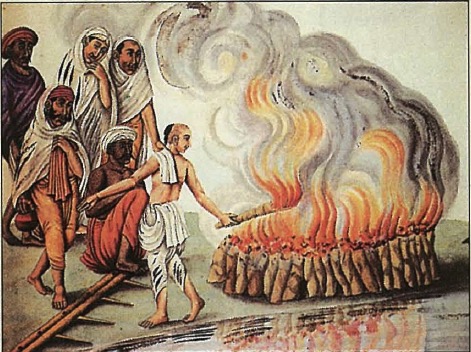By the Editor
General George Patton of World War II fame, no stranger to personal reincarnational remembrances (he claimed to recall previous battlefield experiences as Napoleon), once observed, “For Hindus death is the most exalted experience of life.” This idea is naturally hard for non-Hindus to grasp–all the more so for atheists facing Eternal Oblivion and those of Abrahamic faiths which define death as a punishment for man’s sinful disobedience. To them, death is the ultimate sign of man’s spiritual failure, a belief which arouses instincts of denial and injustice. One may feel penitent and guilty, not to mention uncertain about the destination ahead.
No such thoughts attend the dying days of a Hindu. Of course, there is much sadness surrounding the passing of friends and family, but that is honest acknowledgement of our loving attachments. Inside we know death is OK, natural, that the soul, even if it was less than perfect in this life, is continuing its appointed journey across life’s oceanic phenomena toward Liberation and will, in time and without fail, reach the other shore. The Hindu’s presumption of numerous births mitigates the tragedy of death, whether the passage is his own or another’s. So, Hindus call death by lofty names–Maha Samadhi, “Great Superconscious State” and Maha Prasthana, “Great Departure.” To be near an awakened soul at the time he or she gives up the body is considered among the most blessed of opportunities. While ordinary people are remembered on their day of birth, Hindus honor enlightened souls on the day of their departure, translated in English as “liberation day.”
If we view death as the opposite of life, life is good and death is bad. But death is the opposite of birth, not of life. Seeing life and death as collaborative parts of a greater whole called samsara (the cosmic evolutionary cycle of birth-death-rebirth), life is good and death is equally good, though the Vedas are clear that certain deaths, especially premature ones, are grievous.
The pious Hindu approaches death as a meditation and a spiritual discipline. The body’s impending demise compels him to practice detachment, which is difficult to achieve amid life’s tumult. Lord Yama’s nearness compels new urgency to strive. No longer can he put it off. No more excuses. No more distractions. Death’s knock at the door reminds him of what is transient and what is eternal, and he knows instinctively which to embrace.
Impermanent though life is, we are getting more of it these days. It is estimated that the average life span for prehistoric man was only 18 years. In ancient Greece and Rome it was 20-22. Alexander the Great, having conquered the world, died at the ripe old age of 32. Sankara, having conquered the mind, also died at 32. In Europe in the Middle Ages, life expectancy increased to 36 by the 18th century. By 1841 it was 40 for an Englishman, 42 for his wife. Today it is 70 for men, 75 for women. Hindu tradition says a natural human life is 120 years; some hold this was once the norm in India.
Death may seem static, but it is changing. In modern times life and death have both been extended. Life has gone from a few decades of vitality to many decades ending with diminished health; death has changed from nature’s swift reprieve to a man-made, slow-motion decline which ever more frequently exhausts the emotions and resources of families. Death’s victims have changed, too, going from the very young a few centuries back (when most died as children) to the elderly (over 80% of deaths in the US occur over 65).
Technological systems of life-support have introduced moral, legal and medical questions about what constitutes death, and people are struggling, literally at any cost, to stay alive. Our choice for Most Bizarre: Americans having their heads removed and frozen (at great expense) in hopes future medical advances will conquer presently incurable diseases. Psychedelic guru Timothy Leary shocked many this summer by arranging after his death to have his head surgically removed as part of a film shown at the Cannes Film Festival (some think it a hoax).
Where, how and with whom we die is also changing. Academic Geoffrey Gorer describes how death, once a socially recognized inevitability, has become an embarrassing private trauma in which almost all outside solace, except from intimates, is deemed an intrusion. Death, once the family’s duty, has become the work of paid strangers. Today in North America 75-80% of all deaths occur in hospitals, and 80% of those are “negotiated,” shortened or extended artificially. Many terminal patients are under sedation, so instead of the conscious death Hindus esteem, there is a dim and drugged insensibility at the end.
In response to the exorbitant and mechanical end-game played in hospitals, groups are organizing to regain control. People want to die at home, near nature’s soothing presence, with friends having tea in the next room or listening to the bells from a nearby temple. They don’t want to experience a social mini-death first, followed years later by the physical one.
Death is personified in most cultures. The Greeks called him Thanatos, and to the Romans he was Mors. In India he is Yama, riding on a black water buffalo, dressed in red. The pigeon and owl are his messengers. His weapon is a mace. He carries a noose, called kala-sutra, or “black thread,” with which he snares the life force, prana, and draws it from the body. He is also called Mrityu, “death,” Kritanta, “the finisher,” Bhimasasana, “he of terrific decrees,” Pretaraja, “king of ghosts,” Kala, “time” and Dharma Raja, “king of justice.”
Hindu insights on death (see pages 30 to 33) include the hopeful message of awakened sages who conquered it by conquering life and knew the body’s dissolution as liberation into the Light, as a flowing of the finite into the Infinite.
For those surfing the Web for death resources, here’s a good place to start: http://www.trinity.edu/~mkearl/death.html
